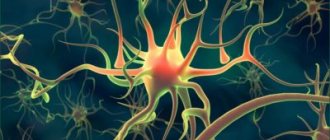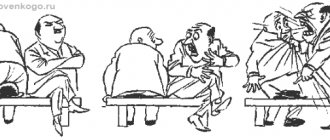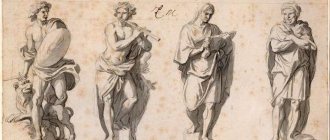The topic to which this article is devoted has been of concern to the global scientific community for several decades - it is directly related to the individual personal characteristics of people.
Everyone knows that the psyche of each person is unique. And this is connected both with the physical and biological characteristics of the organism, and with a complex of social characteristics. If we talk about biologically determined substructures, then, mainly, we need to consider temperament.
What is temperament?
Temperament implies the mental differences of people, which include the depth, intensity and stability of emotions, energy and pace of actions, emotional sensitivity and many other features of mental life. And the problem of temperament today remains controversial and unresolved. But even if we take into account all the diversity of approaches to its study, researchers agree that temperament is the biological foundation on which a person’s personality as a social being is based.
Temperament is a reflection of the dynamic aspects of behavior, which are mainly innate. Its properties are more stable than the properties of other mental characteristics of a person. And its most striking nuance is that the properties of the temperament of one particular person are not combined with each other by chance - they are interconnected naturally and form a certain conglomerate that characterizes the temperament.
To summarize: temperament must be considered as individually unique properties of the psyche that determine the dynamics of an individual’s mental activity; manifested equally in various activities, regardless of its motives, goals and content, and remaining unchanged already in adulthood, and also characterizing in the aggregate the type of temperament.
However, before considering the types of temperament and their features, it should be said that temperament cannot be bad or good, because Each type has its own advantages, and the efforts of any person should be aimed not at correcting its shortcomings, but at effectively applying its advantages in everyday life and activities.
Definition of temperament and brief instructions for interaction
You can guess the temperament of your interlocutor based on observations of him, but this is an ambiguous and complex method. Currently, there are many accurate methods for diagnosis and self-diagnosis.
- Eysenck test. The most popular technique that determines the type of temperament on two scales: stable and unstable, introversion and extroversion. Allows you to determine the severity of each type and the nature of mixed temperament. Suitable for self-diagnosis.
- Another popular technique is the Belov formula. This questionnaire is smaller than the previous one, characterizes only temperaments (without scales), but also gives the value and percentage of each type in a person.
Determining temperament is the first stage, but far from the main one. Much more important is the ability to understand the person opposite and interact with him competently, taking into account his innate characteristics.
Interaction with a choleric person
- Remember that not everything that a choleric person says is really true. It's just that his speech is ahead of his thoughts.
- The conditions and specific emotions of the choleric person at the moment are to blame. Under other conditions, he may say the opposite.
- If, in a fit of anger, a choleric person said something unpleasant, this does not mean at all that he really has a bad opinion of you.
- In a relationship with a choleric person, you should be lenient, not take everything to heart, take into account situations that are individually dangerous for him and avoid them.
- Remember that choleric people do not get hung up on quarrels and conflicts (especially random and momentary ones), they actually forget them and never return to discussions.
- Do not put pressure on the choleric person, especially in work matters.
- Instead, give yourself a break and provide support.
Interaction with a sanguine person
- Communication is the air for a sanguine person. It’s worth getting used to and accepting the fact that there are always a lot of people around him. People are drawn to a sanguine person, and he is drawn to them.
- It seems that it is impossible to argue with him, but this is not so. Despite their optimism and friendliness, sanguine people are rich in “cockroaches”.
- Due to the superficiality of their judgments, sanguine people often make the wrong conclusions. But they cannot be superficial. Remember this and give them a second chance.
- It is difficult for a sanguine person to admit his mistakes; he does not know how to do this. That's why you shouldn't wait for it.
- Face - instructions for a sanguine person. The case when everything is really written on the face. Be observant, and the facial expressions of a sanguine person will tell you everything: what a person thinks, what is pleasant to him, what is unpleasant, and so on.
- Constantly feed it with impressions and events. With monotony and the same type of sensations, a sanguine person gets bored and may leave the relationship. But they become attached to those who always give them new emotions, sensations and conditions of reality for a long time.
- Sanguine people like it when they are asked for advice or asked for their opinion.
- Reason with him, solve problems, make plans.
- Don't neglect extreme sports and adrenaline.
Interaction with a melancholic person
- Avoid loud and sharp sounds and screams.
- Do not resort to a negative assessment of the melancholic person and what is dear to him.
- Avoid criticism, punishment, and reproach. If necessary, choose soft, non-accusatory forms.
- Getting close to a melancholic person is simple - you need to evoke self-pity, tell a sad story, evoke and show sympathy.
- Avoid extreme situations and entertainment.
- Preference should be given to warm, sincere conversations.
- When it comes to films, a melancholic person will prefer drama to horror and thrillers.
- Never say “urgently”, don’t push, don’t demand, don’t order. This drives the melancholic person into a stupor, he begins to frantically make the wrong movements, panics, and does not understand anything.
- In detailed work that requires focus and attention, a melancholic person is an excellent candidate.
- A melancholic person should be introduced to new people gradually and carefully. Don’t “throw him into the hole with all his might.”
- Melancholic people have well-developed intuition, they rarely make mistakes.
Interaction with a phlegmatic person
- You can recognize a phlegmatic person only through communication, but you need to pull everything out with pincers.
- Phlegmatic people are conservatives, so you shouldn’t demand that they quickly get used to and accept something new.
- In new situations or after a non-standard proposal, give the phlegmatic person enough time to think.
- Don’t expect efficiency and speed in other matters either. A person interacting with a phlegmatic person must be able to wait and be patient.
- Don't expect sympathy or other emotional responses, especially momentarily.
- But this does not mean that they are completely indifferent and do not experience emotions. A phlegmatic person may worry about you, but it is difficult for him to squeeze out words or gestures; he would rather silently do something useful for you.
- By the way, they expect the same sympathy from others: support in deeds, not in words.
- If you want to win the favor of a phlegmatic person, then you need to be realistic, avoid fantasies, demonstrate logic and prudence, equanimity and rationality.
- Entertainment, holidays, creativity, and conversations do not attract a phlegmatic person. The matter is important to him.
- The second thing that attracts me is clear, practical, understandable speech. It is recommended to avoid imagery and slang when communicating with a phlegmatic person.
- It is better to write out all requests or tasks for a phlegmatic person on paper, writing them down as clear instructions.
There are no bad or good temperaments; you can find a common language with any person, however, provided that your temperaments coincide.
- For example, a choleric person is incompatible with a sanguine person. These are two leaders.
- Neither a choleric person nor a melancholic person can get along. One does not intentionally, but constantly offends, the other is offensive in itself.
- Choleric and phlegmatic are the best option.
- A sanguine person and a phlegmatic person will often quarrel, but at the same time they can resolve these conflicts. However, dissatisfaction with each other will increase.
- A sanguine person will be suited to his opposite - a melancholic person. Moreover, it is ideal if the sanguine person is a man.
Interesting Facts
I would like to introduce you, dear friends, to some interesting facts about temperaments.
- Happy married couples come from people with different temperaments.
- For friendship, on the contrary, it is important that the temperaments are the same (except for choleric people).
- Phlegmatic people are universal partners in any relationship, but not with phlegmatic people.
- Sanguine people make excellent leaders. A choleric or phlegmatic person is completely unsuitable for such a role.
- Job descriptions and other information should be presented in different forms for each temperament type.
- The phlegmatic person is slow to respond to questions.
- A sanguine person because of haste, and a choleric person because of impetuosity is prone to rash and incorrect answers.
- You need to ask a melancholic person gently and kindly.
- The specificity of people’s speech and the nature of information transfer depend on temperament. We can present the same picture from words of different types in completely different ways.
It is worth noting that in practice pure types of temperament are rarely found; mixed ones are more common. This makes it even more difficult to determine temperament and choose an approach to interacting with a person.
In conclusion, I would like to note that the compatibility of people in temperament, or at least understanding the characteristics of another person, is important for any area of relationships (family, professional, friendly). We often hear the phrase “We didn’t get along in character,” but in fact it would be more correct to say “We didn’t get along in temperament.” And this really can happen.
Creation of typologies of temperament
Since ancient times, people have strived to understand and identify the typical mental characteristics of different people and unite them into a small number of generalizing models. It was these models that were called temperament types; moreover, they were very practical, because through them it was possible to predict the behavior of a person with a certain type of temperament in a specific life situation.
It is officially believed that the doctrine of temperament in general was created by the ancient Greek physician Hippocrates, who argued that people are distinguished by four main “body juices” - blood, phlegm, yellow bile and black bile. Following the teachings of Hippocrates, the equally famous physician of antiquity, Claudius Galen, created the first typology of temperaments of its kind and outlined it in his treatise “De Temperamentum”. According to his ideas, the type of temperament depends on what type of “juice” predominates in the human body. It was Galen who identified four known types of temperament: melancholic (black bile predominates), choleric (yellow bile predominates), phlegmatic (phlegm predominates) and sanguine (blood predominates). The presented concept has been of great importance to scientists for many centuries.
In the dictionary Dictionary of foreign words
a, m.
1. The set of mental properties of a person, characterizing the degree of his excitability and manifested in his attitude to the surrounding reality, in behavior. | Types of people by temperament: melancholic, sanguine, phlegmatic, choleric.
2. Vital energy, the ability to rise internally. A man with temperament. Temperamental - very lively, energetic; having a great, fiery temperament.
Share the meaning of the word:
Constitutional typologies of temperament
Subsequently, many typologies of temperament were put forward. But the greatest interest is caused by those among them where the properties of temperament, interpreted as innate or hereditary, are associated with individual characteristics in physique. Such typologies are called constitutional (typology by W. Sheldon, typology by E. Kretschmer and others). But, of course, such concepts have been criticized by psychologists. And their main drawback is that they underestimate, and often completely lose sight of, the influence of the environment and social conditions on the formation of a person’s psychological properties.
Constitutional theory of Ernst Kretschmer
This typology was created by psychologist and psychiatrist Ernst Kretschmer based on the discovery of stable connections between a variety of temperament and an individual’s innate physique. In simple words, people with certain differences in the constitution of the body have corresponding features of the structure of the psyche.
A preliminary assessment of body structure often helps to establish contact from the first minutes of communication.
Asthenic type (schizothymic)
Absolutely weak-willed, withdrawn, focused on his inner world. Prone to sudden mood swings. On the one hand, he is an intelligent dreamer, on the other, he is a stubborn egoist and abstract dreamer.
Pyknic type (cyclothymic)
He is either at the very top of the emotional wave, or sharply goes to the bottom. Being cheerful, positive and very talkative, he easily gets used to any company, becoming an ideal interlocutor.
Athletic type (ixothymic)
It's hard to surprise him with anything. Calm, reserved, not generous with gestures and facial expressions. It costs him enormous effort to adapt to new conditions. Doesn't have flexible thinking.
The theory of I. P. Pavlov
The fact that the course of mental processes and the behavior of an individual depends on the work of the nervous system, which plays a dominant role in the body, has been known for a long time. But the theory of the connection between temperament types and certain general properties of nervous processes was first proposed by the Russian physiologist I. P. Pavlov. It was subsequently developed by his followers.
In the understanding of Academician Pavlov, the type of nervous system is innate and is least subject to any changes under the influence of upbringing or environment. The properties of the nervous system, according to his ideas, form the physiological basis for temperament, which is a mental manifestation of the general type of the nervous system. Pavlov's subsequent studies on animals made it possible to identify types of nervous systems, which he proposed to extend to humans as well.
A scientific approach to the study of temperament
Modern psychology is actively studying what temperament is and how it affects behavior. Today, scientists share the influence of temperament on a person’s emotionality and activity, so traditional classifications have been improved. Such scientists as Carl Jung, Hans Eysenck, Boris Teplov and other famous scientists worked on the study of temperaments.
The Russian scientist Ivan Pavlov made a great contribution to the study of temperaments. He proved that the higher nervous activity of animals and humans is structured in the same way, therefore types of temperament are also present in animals (they are most pronounced in mammals). Boris Teplov did a lot of work on studying the dynamic features of higher nervous activity. He studied the rate of emergence, progression and cessation of mental processes.
Carl Jung introduced the concepts of introvert and extrovert, reflecting a person’s inclination and ability for interpersonal communication. He paid attention to the dependence of temperament on feelings, thinking, sensations and intuition. In the alternative classification proposed by Jung, 8 personality psychotypes are presented.
Hans Eysenck collected all available information and created a new technique for fairly accurately determining temperament. It remains relevant, providing good accuracy today, due to which it is actively used in modern psychology under the name “Eysenck Temperament Test”.
Components of temperament types
Every person has their own type of nervous system. Its manifestations (these are the characteristics of temperament) are an important part of individual psychological differences. The manifestations of any one type of temperament are very diverse; they can be traced in the manner of behavior, and also manifest themselves in the nature of mental activity, actions, sphere of feelings, motives, cognitive activity, characteristics of a person’s speech, etc.
To compose a psychological characteristic of one of the generally accepted types of temperament, they usually resort to the following basic properties:
- Emotional excitability - the speed of occurrence of an emotional reaction and the force of influence necessary for its occurrence;
- Introversion/extroversion – features of the dependence of a person’s reaction and activity. If they depend on external stimuli, then the person is an extrovert, if they depend on internal ones, then he is an introvert;
- Rate of reactions - the speed with which mental reactions and processes occur, speed of mind, rate of speech, etc.;
- Rigidity and plasticity – a person’s ability to adapt to external influences;
- Reactivity - the degree of involuntary reactions to internal or external stimuli of the same intensity;
- Activity – the intensity of a person’s impact on the outside world and the ability to overcome obstacles on the way to achieving a goal;
- The ratio of reactivity and activity is the dependence of human activity on internal or external circumstances, as well as beliefs, intentions, goals;
- Sensitivity is the level of the lowest intensity of external influence necessary for the occurrence of a mental reaction.
In connection with these properties, the outstanding Polish psychologist and doctor of science Jan Streliau gives the most popular characteristics of temperament types.
Differences between temperament and character
Temperament is the foundation for a larger characteristic of the human personality - character. Sometimes these concepts are not distinguished and confused, although, in a strict sense, they are not the same thing. It was said above about acquired skills, habits, character traits and their difference from innate ones. So, character is precisely the acquired mental properties, although formed under the influence of innate qualities.
The character of representatives of different temperaments may be the same, but it manifests itself in different ways. Thus, phlegmatic people and sanguine people can be equally sociable, but the external manifestation of this sociability will be significantly different. Some specific innate qualities can predetermine the development of some character traits and counteract the emergence of others. It also happens that the development of certain character traits allows a person to restrain negative and currently undesirable innate properties; this phenomenon lies, in particular, at the basis of willpower.
Knowledge about the dependence of innate and acquired qualities allows you to find an individual approach to raising children. A child with any personality type (melancholic, choleric, sanguine or phlegmatic) can develop any character traits, but the methods of education must be different.
Let's return to outstanding personalities. Mikhail Illarionovich Kutuzov was a phlegmatic person by nature, but the corresponding innate mental properties alone could not have made him a famous commander - a choleric person would have been more useful here. Education, training and self-improvement made Kutuzov the way he went down in history.
Isaac Newton seems to us a pronounced phlegmatic person, but his contemporaries described him as a typical melancholic person. Russian Emperor Nicholas I was also melancholic, famous for his harsh “stick” regime of government, military discipline and ruthless fight against corruption - that is, all that, in theory, should reveal a choleric person in him.
In general, character is something that needs training, development and hardening. As a result, even a person with weak innate abilities can show strength of character. This is often observed in emergency situations - for example, during war.
Temperament types
According to J. Strelyau, the four main types of temperament are characterized by the following features:
Melancholic
A melancholic person is a person with high sensitivity and low level of reactivity. High sensitivity often leads to the fact that even a minor reason can cause tears. A melancholic person is painfully sensitive and very touchy. He has inexpressive movements and facial expressions, a quiet voice, poor movements, and a low energy level. As a rule, he is timid, unpersistent, unsure of himself, quickly gives up when doing things, has little ability to work and gets tired easily. The attention of such a person is unstable, all mental processes are slowed down. Most melancholic people are introverts.
Choleric
A choleric person is not particularly sensitive, has high activity and reactivity, and reactivity dominates, which is why he is quick-tempered, impatient, unrestrained, unbridled. Facial expressions, gestures and speech are rich and reflect the mood. His aspirations are stable, his interests are unshakable. The choleric person is persistent and sometimes has difficulty switching attention. In the vast majority of cases, choleric people are extroverts.
Phlegmatic person
A phlegmatic person is characterized by high activity, which dominates over low reactivity. He is insensitive and little emotional. External stimuli have a very weak effect on it; able to remain calm in unexpected situations. Also, phlegmatic people have slow and inexpressive movements, the same speech, and poor facial expressions. He has difficulty switching his attention, rebuilds habits and skills very slowly, but he has energy and high performance. Most phlegmatic people are introverts.
Sanguine
A sanguine person is a person with high reactivity, which is on par with activity. It is characterized by lively facial expressions, a wealth of gestures, a quick response to external circumstances, and ease of switching attention. Very sensitive, active, can work for a long time without getting tired. Disciplined, resourceful, has good ability to concentrate and self-control. His interests, moods and hobbies can change quickly. Almost all sanguine people are extroverts.
The influence of temperament on human life
Temperament largely determines certain aspects of an individual's life. Eg:
- shaping his environment;
- quality of life, feeling of internal and external comfort;
- the ability to withstand difficulties and adapt to new conditions;
- achievements and losses;
- perception of what is happening;
- susceptibility to emotions when making important decisions or a cool-blooded analysis of possible consequences and much more.
Summary
As noted above, none of the temperament types are either bad or good. In addition, a person cannot belong to only one single type - he can only have a predominant one, and the rest will be complementary. But, be that as it may, from the perspective of psychological science, types of temperament are only one of the ways of psychological assessment of a personality. You should also be aware that descriptions of temperaments may differ from one specialist to another and include many factors.
In Dahl's dictionary
M. lat. the nature of man, his natural constitution, in accordance with the basic qualities of the soul; There are four main temperaments: sanguine (alo-blooded), choleric (nervous), phlegmatic (white-blooded) and melancholic (black-blooded). Temperature, degree of heat, measure of hot and cold, using a thermometer. The room temperature is 15 degrees, the temperature in the room is 15°C. The average temperature in Paris is higher, and in Stockholm lower than in Moscow, in Paris it is warmer, in Stockholm it is colder, all year round.
The history of the term “temperament”
It's no secret that working in a close-knit team is much easier, calmer and more effective. If conflicts often occur in a team, their consequences negatively affect not only joint activities, but also the well-being of each team member. All people are very different: with their own habits, characters and temperaments. But what is “temperament”, “types of temperament”, what impact do they have on team cohesion, we have to figure it out!
The term “temperament” goes back to the views of ancient science on the nature of individual psychological differences. Ancient Greek medicine, represented by its largest representative Hippocrates (5th century BC), believed that the state of the body depended mainly on the quantitative ratio of “juices” or fluids present in the body: blood, lymph and bile. Roman physicians working several centuries later designated the proportions in the mixing of these juices with the Latin word temperamentum, which means “proper proportion of parts,” from which the term “temperament” is derived. Gradually, in ancient science, the idea became widespread that the mental characteristics of people depended on temperament, that is, on the proportion in which the main “juices” were mixed in the human body. Each of them was characterized by the predominance of a liquid.
The mixing of fluids in the body, characterized by a predominance of blood, was called the sanguine temperament (from the Latin word “sanguis” - blood); mixing, in which lymph predominates, is a phlegmatic temperament (from the Greek word “phlegm” - mucus); mixing with a predominance of yellow bile - choleric temperament (from the Greek word "chole" - bile) and, finally, mixing with a predominance of black bile - melancholic temperament (from the Greek word "melaina chole" - black bile).
The doctrine of the organic basis of temperament, created by ancient science, is now of only historical interest. However, the term “temperament” has firmly entered science, and to this day the division of people, depending on their temperament, into four types has retained its meaning.
Physiological basis of temperament
Already in our time, a number of domestic scientists (I.P. Pavlov, D.M. Teplov, V.D. Nebylitsyn, etc.) wondered what the physiological basis of temperament is. They put forward the doctrine of the types of the nervous system, or the properties of the nervous system. I. P. Pavlov and his colleagues, based on numerous experiments on dogs, identified several main types of the nervous system.
A strong type of nervous system is able to withstand very strong stimuli and is efficient; weak type - sensitive, receptive, but does not tolerate heavy loads well and under extremely strong stimuli (for a person this can be stress) tends to fall into “exorbitant inhibition” (the nervous system cannot withstand the load and protects itself - it seems to temporarily switch off, stops responding) .
In addition, the type of nervous system can be balanced or unbalanced (for example, when a person is difficult to “get angry” - this is a balanced type), as well as mobile or inert (quickly or difficultly switches from one type of activity to another). Inertia and difficulty in switching are also called rigidity; this can be reflected in behavior as conservatism, adherence to the same order, pedantry.
The type of nervous system is its innate property, which, however, can change somewhat under the influence of living conditions. In the school of I.P. Pavlov, the idea was formed that the type of nervous system is closely related to behavioral characteristics, forming the basis of human temperament.
So, temperament is the individual characteristics of a person that determine the dynamics of his mental processes and behavior. Dynamics is understood as tempo, rhythm, duration, intensity of mental processes, in particular emotional processes, as well as some external features of human behavior - mobility, activity, speed or slowness of reactions, etc.
I. P. Pavlov established a relationship between the type of nervous system and temperament:
• strong, balanced, agile type – sanguine;
• strong, balanced, inert type – phlegmatic;
• strong, unbalanced type with a predominance of excitement - choleric;
• weak type – melancholic.
Psychological characteristics of temperament
There is a psychological interpretation of temperament: each of the four types of temperament is determined on the basis of certain characteristic psychological characteristics.
A person with noticeable mental activity, quickly responding to surrounding events, striving for frequent changes of impressions, experiencing failures and troubles relatively easily, lively, active, with expressive facial expressions and movements is called a sanguine person. A sanguine person quickly gets along with people, is sociable, cheerful, easily switches from one type of activity to another, but does not like monotonous work. He easily controls his emotions, quickly gets used to a new environment, and actively comes into contact with people.
A person who is unperturbed, with stable aspirations and mood, with constancy and depth of feelings, with uniformity of actions and speech, with a weak external expression of mental states is called a phlegmatic person. A person of this temperament is: slow, calm, unhurried, balanced. In his activities he demonstrates: thoroughness, thoughtfulness, perseverance. As a rule, he finishes what he starts. In relationships with people, a phlegmatic person is always even, calm, moderately sociable, his mood is stable, a phlegmatic person is not easily enraged and emotionally hurt.
A person who is very energetic, capable of devoting himself to a task with particular passion, fast, assertive, prone to violent emotional outbursts and sudden changes in mood, with rapid movements is called choleric. The predominance of excitation over inhibition, characteristic of this type of nervous activity, is clearly manifested in the incontinence, impetuosity, hot temper, and irritability of the choleric person. Hence the expressive facial expressions, hasty speech, sharp gestures, unrestrained movements. The feelings of a person with choleric temperament are strong, usually clearly manifested, and arise quickly; the mood sometimes changes dramatically. In communicating with people, a choleric person admits harshness, irritability, and emotional incontinence, which often does not give him the opportunity to objectively evaluate people’s actions, and on this basis he creates conflict situations in the team. Excessive straightforwardness, hot temper, harshness, and intolerance sometimes make it difficult and unpleasant to be in a group of such people.
A person who is impressionable, prone to deep experiences, easily vulnerable, but outwardly weakly reacts to the environment, with restrained movements and muffled speech is called a melancholic. Feelings and emotional states in people of melancholic temperament: arise slowly, but are distinguished by depth, great strength and duration; melancholic people are easily vulnerable, have a hard time withstanding insults and grief, although outwardly all these experiences are poorly expressed in them. Representatives of the melancholic temperament are prone to isolation, loneliness, avoid communication with unfamiliar, new people, are often embarrassed, and show great awkwardness in a new environment. Everything new and unusual causes melancholics to become inhibited.
It should be remembered that the division of people into four types of temperament is very arbitrary. There are transitional, mixed, intermediate types of temperament; Often a person's temperament combines traits of different temperaments.
The famous English psychologist Hans Eysenck proposed to determine the type of temperament depending on the ratio of such personality traits as introversion - extraversion and emotional stability - neuroticism. The indicator “introversion - extraversion” characterizes a person’s individual psychological orientation either to the world of external objects (extraversion) or to the internal subjective world (introversion).
It is generally accepted that extroverts (sanguine and choleric) are characterized by sociability, a desire to be among people, impulsiveness, flexibility of behavior, great initiative and high social adaptability. Introverts (phlegmatic and melancholic) are characterized by: unsociability, withdrawal, a rich inner world, social passivity (with sufficient persistence), and a tendency to introspection.
The neuroticism indicator characterizes a person in terms of emotional stability (stability). This indicator is also biopolar and forms a scale, at one pole of which there are people characterized by high emotional stability and excellent adaptation - sanguine and phlegmatic people, and at the other - nervous, unstable and poorly adapted individuals - choleric and melancholic.
Temperament and personality
Temperament is the natural basis for the manifestation of psychological qualities of an individual. However, with any temperament, it is possible to develop in a person qualities that are unusual for a given temperament. Psychological research and pedagogical practice show that temperament changes somewhat under the influence of living conditions and upbringing. Temperament can also change as a result of self-education. Even an adult can change his temperament in a certain direction. It is known, for example, that A.P. Chekhov was a very balanced, modest and delicate person. But here is an interesting fact from his life. In one of his letters to his wife O. L. Knipper-Chekhova, Anton Pavlovich makes the following valuable confession: “You write that you envy my character. I must tell you that by nature I am harsh, I am quick-tempered. But I am used to restraining myself, because it is not proper for a decent person to let himself go. “It is interesting to note that some people, having learned the characteristics of their temperament, deliberately themselves develop certain methods in order to master it. This is what A. M. Gorky did, for example, to restrain the violent manifestations of his temperament. To do this, he deliberately switched to various side actions with objects. With people who expressed views opposite to his, A. M. Gorky tried to be dispassionate and calm.
Cohesion
2. 1. The concept of cohesion
Cohesion (of a group, team) is a characteristic of a system of intra-group connections, showing the degree of coincidence of the group’s assessments, attitudes and positions in relation to objects, people, ideas, events, etc., that are most significant for the group as a whole.
Group cohesion is one of the processes of group dynamics, characterizing the degree of commitment to the group of its members.
How its specific indicators are usually viewed:
1) the level of mutual sympathy in interpersonal relationships: the more group members like each other, the higher its cohesion;
2) the degree of attractiveness (usefulness) of the group for its members - the greater the number of people satisfied with their stay in the group - those for whom the subjective value of the benefits acquired through the group exceeds the significance of the efforts expended - the higher the force of its attraction and cohesion.
According to the ideas of the founders of the concept of group cohesion (American psychologists K. Levin, L. Festinger, D. Cartwright, A. Zander and their followers), group cohesion is a kind of resultant of the forces that keep people in a group.
2. 2. Factors of group cohesion
The main factors of group cohesion most often include:
1) the similarity of the basic orientations of the value members of the group;
2) clarity and certainty of the group goal;
3) democratic style of leadership (management);
4) cooperative interdependence of group members in the process of joint activities;
5) optimism and vigor of collective life and activity;
6) feeling of security;
7) the presence of public opinion;
 the presence of a positive psychological climate;
the presence of a positive psychological climate;
9) relatively small group size;
10) prestige of the group.
A highly developed, cohesive team is characterized by the presence of a friendly background of relationships, emotional empathy, and sympathy for each other.
Chapter III
Practical work. Research results
Based on theoretical knowledge and practical observations of the behavior of students at our school, we assumed that the types of temperaments affect the cohesion of the team: if sanguine and phlegmatic people predominate in the team, then the cohesion of the team should be high; if choleric and melancholic people predominate in a team, then the cohesion of the team should be low.
To confirm or refute our hypothesis, we conducted the “Temperament Formula” test with the respondents, with the help of which we determined the types of temperaments, and the “Group Cohesion Questionnaire”, to identify the levels of team cohesion. The respondents were 8th grade students. A total of 56 people took part in the survey.
Diagnostic results for class 8A students - 18 people in total.
A comparative analysis of the results allows us to draw the following conclusions:
• in the class there are 67% sanguine people, which corresponds to high and above average (67% in total) levels of team cohesion;
• the number of choleric and melancholic people is 33%, which corresponds to average and below average (33% in total) levels of team cohesion.
Diagnostic results for 8D grade students - 20 people in total.
A comparative analysis of the results allows us to draw the following conclusions:
• in the class of sanguine and phlegmatic people there is only 70%, which corresponds to high and above average (70% in total) levels of team cohesion;
• the number of choleric and melancholic people is 30%, which corresponds to the average (only 30%) level of team cohesion.
Diagnostic results for 8E grade students - 18 people in total.
A comparative analysis of the results allows us to draw the following conclusions:
• in the class of sanguine and phlegmatic people there is only 66%, which corresponds to high and above average (66% in total) levels of team cohesion;
• the number of choleric and melancholic people is 34%, which corresponds to average and below average (34% in total) levels of team cohesion.
General diagnostic results for all classes:
A comparative analysis of the results allows us to draw the following conclusions:
• in all classes of sanguine and phlegmatic people only 68%, which corresponds to high and above average (68% in total) levels of team cohesion;
• the number of choleric and melancholic people is 32%, which corresponds to average and below average (32% in total) levels of team cohesion.
General conclusions: Thus, the results of this study allow us to confirm our hypothesis about the influence of temperament types on team cohesion.
Conclusion
The work is devoted to the problem of the influence of temperament types on team cohesion.
The study of psychological and pedagogical literature allowed us to draw the following conclusions:
1. 1. Temperament is the individual characteristics of a person that determine the dynamics of his mental processes and behavior.
1. 2. There is a relationship between the type of nervous system and temperament:
• strong, balanced, agile type – sanguine;
• strong, balanced, inert type – phlegmatic;
• strong, unbalanced type with a predominance of excitement - choleric;
• weak type – melancholic.
1. 3. Each of the four types of temperament is determined on the basis of certain characteristic psychological characteristics.
1. 4. The type of temperament can be determined depending on the ratio of such personality traits as introversion - extraversion and emotional stability - neuroticism.
1. 5. The division into types of temperaments is very arbitrary; there are transitional, mixed, intermediate types of temperament; Often a person's temperament combines traits of different temperaments.
1. 6. With any temperament, it is possible to develop in a person qualities that are unusual for a given temperament.
2. Cohesion (of a group, team) – a characteristic of a system of intra-group connections, showing the degree of coincidence of the group’s assessments, attitudes and positions in relation to objects, people, ideas, events, etc., that are most significant for the group as a whole; one of the processes of group dynamics, characterizing the degree of commitment to the group of its members.
3. Having analyzed the psychological literature, we assumed that the types of temperaments influence the cohesion of the team: if sanguine and phlegmatic people predominate in the team, then the cohesion of the team should be high; if choleric and melancholic people predominate in a team, then the cohesion of the team should be low.
We tested our assumption with a practical study using the “Formula of Temperament” and “Group Cohesion Questionnaire” methods.
Analysis of the research results led to the conclusion that types of temperament affect team cohesion.
Taking into account the results of our research, we have developed recommendations for students and teachers. We plan to familiarize students (in class) and teachers with the results of this study and recommendations.
Representatives of different temperaments from different sides
Everyone knows that everything has both positive and negative sides. And temperament in this sense is no exception. Each type has both its pros and cons, which we will discuss below.
If you educate correctly and do not overdo it with control or self-control, then each representative can express himself like this:
- phlegmatic people are self-possessed people who are alien to hasty decisions;
- melancholic people are people who deeply care about others and are very impressionable;
- sanguine people - can become responsive people who are ready for any work;
- choleric people will become passionate and active people in work.
As for the negative aspects, different types have their own disadvantages:
- melancholic people are withdrawn and shy;
- phlegmatic people are indifferent to people and the environment;
- sanguine people are superficial and scattered, they are fickle;
- choleric people are always in a hurry, and everything is done hastily.
How to determine your personality type
Determining your personality type is quite simple. To do this, you can use different methods and tests. In addition, to save effort and time, you can take them online. The main goal of such questionnaires is to understand exactly how a person will react to a particular situation.
To obtain objective results, psychologists recommend giving quick and clear answers. You don’t need to think a lot about solving this or that issue, you need to act depending on the emotions that arise first
It is worth noting that there are no right or wrong questions in such tests. There is no good or bad answer here.
Melancholic people can only work in a calm and familiar environment
additional literature
- Great Soviet Encyclopedia: In 30 volumes - M.: “Soviet Encyclopedia”, -.
- Chess., S. (1997). Temperament: Theory and Clinical Practice. Harvard Mental Health Letter, 14(5), 5-7.
- Davidson, D. A. (2005). Psychosocial Issues Affecting Social Participation. In J. Case-Smith (Ed.), Occupational Therapy for Children (pp. 449–480). St. Louis: Elsevier Mosby.
- Maziade, M. (1983). Le tempérament de l'enfant, les différences individuelles et les forces environnementales. Santé mentale au Québec, 8(2), 61-67.
- Olson, L. J. (1999). Psychosocial Frame of Reference. In P. Kramer & J. Hinojosa (Eds.), Frames of Reference for Pediatric Occupational Therapy (pp. 323–375). Philadelphia: Lippincott Williams & Wilkins.
- Zeanah, C. H., & Fox, N. A. (2004). Temperament and Attachment Disorders. Journal of Clinical Child & Adolescent Psychology, 33(1), 32-41.
The power of education, childhood trauma
Various psychological traumas received in childhood undoubtedly influence the formation of personality, but this mostly relates to the character of the individual. Temperament can help to withstand pressure, injustice, misunderstandings and other situations that often occur at the instigation of parents, relatives or teachers. A different type of temperament, on the contrary, forces you to cave in, resign yourself, or fall into deep depression and hatred of the world.
Theories of temperament of the 20th century abroad
From the point of view of psychology, the four temperaments are only one of the possible systems for assessing psychological characteristics (there are others, for example, Jung’s types, “introversion - extraversion” by Hans Eysenck). Descriptions of temperaments vary quite a bit among different psychologists and seem to include a fairly large number of factors. Attempts have been made to provide a scientific and experimental basis for the theory of temperaments (I. P. Pavlov, G. Yu. Eysenck, B. M. Teplov and others), however, the results obtained by these researchers are only partially compatible with each other. Blyumina (1996) and Trofimova attempted to compare the theory of temperaments with all psychological typologies known at that time (more than 100), including from the point of view of methods for determining these types. Modern science sees in the doctrine of temperaments an echo of the ancient classification of four types of mental response in combination with intuitively noticed types of physiological and biochemical reactions of the individual.
Many psychologists, as proposed by Kant at the end of the 18th century, Heymans at the beginning of the 20th century and G. Yu. Eysenck in the 1960s, divide the components of temperament into 2 groups: “Activity” of behavior and “Emotionality”. Activity of behavior is characterized by the degree of energy, swiftness, speed, or vice versa, slowness and inertia. In turn, emotionality characterizes the course of emotional processes, determining the sign (positive or negative) and modality (joy, grief, fear, anger, etc.).
Gray, who analyzed the work of Russian psychologists in the field of temperament, proposed a 2-dimensional model in which 4 Hippocratic types were placed on the scales of the Behavior Activation System and Behavior Inhibition System. The ratio of “high” and “low” levels, for each of these two independent parameters, gives a certain individual characteristic of a person, and, as a result, a formal definition of each of the four temperaments. On emoticons (see picture above) you can interpret a smile as the ease of inhibition processes, and frowning eyebrows as a manifestation of ease of excitement.
Abroad, the main research in the field of temperament was carried out in the fields of child psychology (Buss & Plomin, 1984; Chess & Thomas, 1996; Kagan & Snidman, 2009; Rothbart et al, 2000; Windle & Lerner, 1986), clinical psychology and psychiatry (Akiskal , 1998; Cloninger, 1986, 1994; Mehrabian, 1996; Panksepp et al, 1987; Zuckerman, 1994). In relation to adult temperament, this concept has been merged overseas with the concept of personality, and has been analyzed as “biologically based personality traits” (Cattel, 1965; Digman & Takemoto-Chock, 1981; Goldberg 1993; Guilford & Zimmerman, 1956; McCrae & Costa 1997 ; Norman, 1963). Such a fusion is not recommended, since the concept of personality refers to socio-cultural processes, values, attitudes, personal experiences, self-esteem and the range of a person's relationships with other people, while temperament, according to the initial definition, refers to the neuro-chemical balance of the body.











